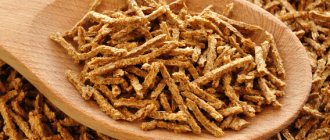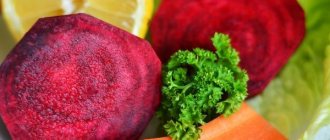The pressing problem of many women is excess weight. Sometimes, getting rid of a few kilograms is very difficult. All this is influenced by the speed of metabolic processes and physical activity. Also, to lose weight you need to reconsider your diet. Nutritionists recommend including dietary foods in your daily menu. One such product is figs. Figs grow on the fig tree and are the oldest cultivated fruit. And it is difficult to overestimate the beneficial, medicinal properties of the product. Today there are a large number of diet options based on exotic fruits.
general characteristics
Figs are the fruits of a subtropical tree of the ficus genus. On rocky soil it grows as a shrub, although in more favorable conditions it can grow into an 11-meter tree. During a season, one such plant can produce several hundred fruits.
Content:
- general characteristics
- Nutritional value
- Benefits for the body
- Other useful properties
- Use in cosmetology
- Some Caveats
- How to choose and store correctly
- How to eat a fig tree
Fruits of different varieties may differ not only in color, but also in taste. The color of the fruit can range from black-purple to greenish-yellow, and the color of the flesh can range from soft pink to purple or amber. However, they are all pear-shaped, with juicy pulp and multiple seeds inside. Biologists say there are more than a thousand varieties of figs.
The fig tree has a long and rich history [1]. Archaeologists have found fossilized figs in Neolithic settlements. There is mention of these fruits in the Bible and other ancient writings. Some researchers suggest that the forbidden fruit in the Garden of Eden was not an apple, but a fig.
It is believed that the ancient Egyptians were the first to grow these trees, although according to another version, the plant’s homeland is Asia Minor. Then the plant appeared in Crete, and around the 9th century BC. e. The ancient Greeks made figs a staple of their traditional diet. They revered these fruits so much that they even created a law prohibiting the export of the best varieties of fig trees. In ancient Rome, the fruit was considered sacred. According to legend, the she-wolf who nursed the founders of Rome, Romulus and Remus, loved to rest under a fig tree. Already in ancient times, the ancients knew about 30 varieties of this culture. The fig tree was brought to the Western Hemisphere by Spanish conquerors in the 16th century. Today, some of the largest producers of figs are Turkey, Greece, Spain and Portugal. The fig tree grows in the Caucasus, Central Asia, Crimea, the Carpathians, as well as in the Mediterranean countries, in some regions of Azerbaijan, Armenia, Georgia, and Russia.
Rules for eating figs for weight loss
If you are losing weight on a diet, you need to be careful with figs, regardless of their beneficial properties. Several dried fruits contain up to 50 kcal, and 100 g contain about 220-250. Thus, you should not eat these berries in large quantities if you are losing weight.
By eating a couple of berries half an hour before meals, you will overcome the feeling of hunger and satiety will come to you earlier during the meal. Five berries can replace an afternoon snack and even dinner. Some nutritionists advise periodically doing fasting days on figs, drinking them along with unsweetened drinks; there is even a diet on figs.
It is noteworthy that fresh sweet berries do not aggravate thirst, but rather saturate the body with fluid. If you want to eat dried figs while losing weight, it is better to pre-soak them in cold water for 30-60 minutes. This way you neutralize the preservatives used to process fruits in order to improve their storage.
If you are on a strict diet and suddenly want something sweet, eat some figs instead of sweets or chocolate. It contains almost no fat, although simple carbohydrates are present. Dried fruits are healthier than any sweets, especially for those losing weight.
Nutritional value
Fig fruit is a delicious dessert with few calories but rich in fiber, minerals, vitamins and antioxidants [2].
Interestingly, figs are compared to apples in terms of antioxidant content.
If we talk about dried fruits, then the concentration of all components in them increases several times. True, this also applies to calorie indicators: 100 g of dried fruit contains almost 250 kcal versus 74 kcal in the same amount of fresh fruit. Nutritional value per 100 g of fresh fruit
| Calorie content | 74 kcal |
| Carbohydrates | 19.2 g |
| Squirrels | 0.76 g |
| Fats | 0.34 g |
| Cellulose | 2.9 g |
| Vitamin A | 142 IU |
| Vitamin B1 | 0.08 mg |
| Vitamin B2 | 0.07 mg |
| Vitamin B3 | 0.53 mg |
| Vitamin B5 | 0.42 mg |
| Vitamin B6 | 0.12 mg |
| Vitamin B9 | 7 mcg |
| Vitamin C | 2.4 mg |
| Vitamin E | 0.13 mg |
| Vitamin K | 4.73 mcg |
| Sodium | 1 mg |
| Potassium | 234 mg |
| Calcium | 33.6 mg |
| Copper | 0.05 mg |
| Iron | 0.34 mg |
| Magnesium | 17.4 mg |
| Zinc | 0.14 mg |
| Selenium | 0.2 mcg |
How many figs can you eat per day?
It is important to know not only how to eat figs, but also in what quantities you can eat them. If we talk about traditional medicine, it is recommended to consume the fruit in the form of infusions and decoctions. However, do not forget that chronic diseases may be a contraindication for consuming the fruit.
You should also understand that you should not eat too many fruits at once, as this can negatively affect your health.
If you have no contraindications, then you are allowed to consume no more than 10 figs per day. Otherwise, you risk experiencing problems with your body.
Benefits for the body
The rich chemical composition of the fig tree makes the fruits beneficial: they prevent and treat many disorders in the body [3].
The healing effects of the fruit are known for diabetes, bronchitis, asthma, stomach and genitourinary disorders [4].
Reduces blood pressure
Fig fruits are good sources of potassium, a mineral that affects blood pressure. Many people's diets include not enough fruits and vegetables, but an excessive amount of very salty foods. Under such circumstances, potassium deficiency, sodium excess and, as a consequence, hypertension develop. Laboratory studies have shown that adding figs to your diet can help restore healthy potassium levels and stabilize blood pressure in just a few weeks.
Promotes weight loss
The fruits of the fig tree are rich in fiber, which greatly affects body weight. Researchers say that eating foods containing dietary fiber not only keeps you full longer, but also promotes faster weight loss. Fresh figs are also a good source of fiber. However, it is important to understand that in dried form it is a very high-calorie product, and for those who want to get rid of extra pounds, this is not very good news.
Useful for diabetes
Few realize that fig leaves can also be included in the diet. However, in some cultures these greens are actively consumed, and, as researchers say, they do it right. Substances that have antidiabetic properties have been discovered in fig tree leaves. This means that diabetics consuming fig leaf extract require lower doses of insulin injections [5].
Protects the cardiovascular system
An animal study found that an extract derived from green fig leaves was able to reduce triglyceride concentrations (the form in which fats are found in the blood). Fruits contain pectin, which is a soluble fiber that cleanses the body of excess cholesterol [6]. And this is an important fact for maintaining heart health. Dried fig fruits are no less useful. They contain phenols, Omega-3 and Omega-6. These fatty acids reduce the likelihood of developing coronary heart disease.
Has anti-cancer properties
And again we will talk about fig leaves.
Not long ago, scientists added one more to the list of beneficial properties of this plant – the ability to protect against cancer.
Based on the results of laboratory experiments, researchers suggested that fig leaf extract contains substances that inhibit the growth of certain types of cancer cells, including skin cancer [7]. The fiber contained in fruits protects the body from free radicals and prevents the growth of malignant tumors in the intestines. For the female body (especially after menopause), fruits are useful as a preventive measure against breast cancer. By the way, figs are also popular in Chinese medicine as a natural anti-cancer medicine.
Improves digestion
It is enough to eat 3 fig fruits daily to protect yourself from many digestive system disorders. In particular, the fiber contained in fruits improves intestinal motility, regulates its functioning and prevents constipation [8].
Powerful antioxidant
A huge amount of antioxidant substances are concentrated in the leaves, pulp and peel of fig tree fruits.
They stop oxidative processes in the body. Researchers say the dried fruit contains more antioxidants than fresh figs. This fact should comfort people who have no access to these exotic fruits in fresh form.
Restores calcium reserves
Figs are rich in calcium, which makes the fruit one of the foods that strengthen bones and reduce the risk of osteoporosis. In addition, its fruits contain phosphorus, which also stimulates the growth of bone tissue [9].
Treats bronchitis
The unique chemical composition of fig tree leaves makes them an ideal component for medicinal tea. Brewed greens of this plant are useful for respiratory diseases and bronchitis. This remedy is also used to prevent and relieve attacks in patients with asthma.
Antibacterial and antifungal agent
Malaysian scientists have said that fig tree fruits have antibacterial and antifungal properties. Experience has shown that the substances contained in the fruit kill harmful bacteria in the oral cavity, and also cause the death of some fungi.
Eliminates sexual dysfunction
For centuries, traditional healers have used figs to treat sexual dysfunction, infertility or weak erections. Figs are known in many cultures as a powerful aphrodisiac. To restore sexual strength in ancient times, it was advised to eat 2 fruits daily, which were previously soaked in milk overnight.
Smoothes wrinkles
Indian pharmacists also made their contribution to the study of the beneficial properties of figs. After a series of studies, they announced: fig tree extract effectively smoothes wrinkles, and also lightens age spots, freckles and acne marks [10].
The best dried fig recipes
There are many different recipes that you can use dried fruit in. It will be an appropriate addition to cereals, salads, and meat dishes. Before using, you need to wash the figs thoroughly.
- Soaked fruit added to a salad of shredded cabbage, carrots and apple will not only improve its taste, but also saturate the body with vitamin C and help strengthen vascular walls.
- A mixture of figs and cottage cheese will help provide the body with the daily requirement of pectin, vitamin D and calcium. The curd mixture can be whipped in a blender. You can eat it with natural yogurt. If you cut a fresh fruit and put a piece of cheese into the cut, you can get a good appetizer for table wine or champagne.
- A mixture made from figs, dried apricots, raisins, and prunes helps maintain normal heart function. Fruits should be taken in equal quantities. Add walnuts, honey and lemon juice to them. Twist everything through a meat grinder or put it in a blender. Eat 2 tsp. 3 times a day 30 minutes before meals.
- Nut-fig butter is suitable for spreading on biscuits or apple slices. Nuts and figs, taken in equal quantities, are twisted through a meat grinder. Add a little lemon juice to the resulting mixture.
- To add a little piquancy to the taste of rice or oatmeal, coarsely chopped soaked figs are added to the finished dish.
- When making smoothies, figs can be used as a base instead of bananas. It goes well with other ingredients.
- Among meat dishes, figs go best with lamb and poultry. It is added to sauces. However, we must remember that during heat treatment some of the beneficial properties of figs are lost.
We recommend that you read: Use of oak acorns
To prepare an effective remedy for coughs, bronchitis and colds, you need to cut 2 fruits into several parts, pour in 500 ml of milk and leave for 1 hour. Then bring the mixture to a boil, remove from heat, cover and cool to room temperature. Take the prepared decoction ½ cup 3 times a day before meals.
Other useful properties
The list of medicinal properties of figs does not end there.
Over the years of research into the functions of the fig tree, scientists have identified its healing abilities for more than 40 diseases of the digestive, endocrine, reproductive and respiratory systems [11].
Figs have a beneficial effect on the body when:
- sore throat;
- whooping cough;
- indigestion;
- abdominal cramps;
- fever;
- anemia;
- liver diseases;
- paralysis;
- skin diseases;
- ear pain;
- poor vision;
- boils;
- abscesses;
- venereal diseases;
- improper body acidity [12].
How safe is losing weight on a fig diet: reviews, results of losing weight
Very often, doctors criticize various methods of weight correction, which cannot be said about the fig diet: it is quite harmless if you follow it no more than three times a year and have no contraindications. Nutritionists advise switching to proper nutrition after weight correction, because... Only with its help can you maintain weight in the future.
How should the correct exit after a diet occur:
- If the diet has not been changed too much previously, you can continue to eat the same. With restrictions such as a menu with milk or kefir, new products should be introduced gradually;
- You can’t immediately pounce on previously forbidden food, because... this will overload the gastrointestinal tract, but subsequently it should be limited so as not to gain weight again.
The results of the diet, as a rule, please those who decide to try it:
- Depending on the specific technique, weight is gained or lost;
- There is a noticeable improvement in bowel function;
- Metabolism is stabilized.
Use in cosmetology
Fig pulp puree applied to the skin of the face will help get rid of acne. Cosmetologists advise applying medicated masks daily for 15-20 minutes. And the milky juice from the fig stem will help get rid of warts and corns. Baked fruit gruel treats boils, abscesses, and skin inflammations. The antioxidant properties of fig juice will restore beautiful color, radiance and smoothness to the skin.
The pulp of the fruit is suitable for making homemade scrubs (mix with sugar and a small amount of olive oil) and a variety of masks. One of the most effective masks for improving skin tone consists of fig pulp, ginger powder, oatmeal and a few drops of bergamot essential oil. The peel of a fresh fig tree, which should be used to wipe your face, will help restore smoothness to your skin.
The healing properties of figs are also beneficial for hair. In particular, masks based on fruit mass make curls manageable, smooth, shiny, moisturize them and prevent the appearance of gray hair.
How to choose and store correctly
Fresh figs are a perishable fruit that should preferably be eaten within a day or two after purchase.
Good fresh fruit is easy to recognize by its rich color, soft texture (but not spongy), and firm stem. The aroma of the ripe fruit is delicate and sweet. A sour smell indicates that it has begun to deteriorate; a bitter smell indicates that the fruit is not yet ripe. It is better to give preference to completely ripe ones, as they contain more antioxidants.
When buying dried fruits, it is also important to pay attention to their appearance, texture and smell. They should also be soft, with a pleasant smell, without damage or mold.
Ripe fruits should be stored in the refrigerator, wrapped in paper or placed in a shallow container. This is necessary so that the delicate fruits do not dry out or become crushed. Unripe fruits are stored at room temperature, but away from sunlight. Dried ones will stay fresh for several months if stored in a cool, dark place (maybe the refrigerator). In any case, fig tree fruits must be isolated from extraneous pungent odors, since they have the ability to quickly absorb aromas from the outside.
How do you eat fresh figs - with or without peel?
As a rule, people have a question about how to eat figs - with or without peel? In fact, the skin itself is not prohibited from being eaten, despite its bitter taste. Before eating the fruit, rinse it under running water and wipe dry. To make it more convenient, cut the fruit into four parts. Be sure to remove the stem.
If you want to give figs to your child, it is better to do it without the skin. Cut the fruit in half and give your child a dessert spoon to eat from the peel.











